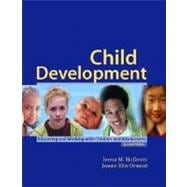
| Making a Difference in the Lives of Infants, Children, and Adolescents | |
| Methods of Inquiry in Child Development | |
| Physical Development | |
| Cognitive Development | |
| Piaget and Vygotsky | |
| Cognitive Development | |
| Cognitive Processes | |
| Intelligence | |
| Language Development | |
| Development of Literacy: Reading and Writing | |
| Personal and Emotional Development | |
| Social Understanding and Moral Development | |
| Development of Motivation and Self-Regulation | |
| Families | |
| Interpersonal Relationships | |
| Growing Up in Context | |
| Glossary | |
| References | |
| Photo Credits | |
| Name Index | |
| Subject Index | |
| Table of Contents provided by Publisher. All Rights Reserved. |
The New copy of this book will include any supplemental materials advertised. Please check the title of the book to determine if it should include any access cards, study guides, lab manuals, CDs, etc.
The Used, Rental and eBook copies of this book are not guaranteed to include any supplemental materials. Typically, only the book itself is included. This is true even if the title states it includes any access cards, study guides, lab manuals, CDs, etc.